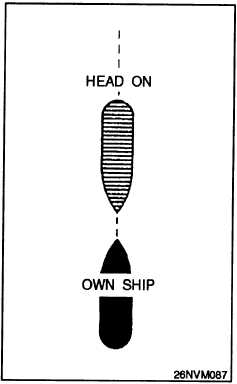| |
Steering and Sailing Rules
Information
In this portion of the chapter a short discussion of the steering and
sailing rules will be presented, but the majority of our discussion will be
about part D, which contains the requirements for sound signals.
You must understand the steering and sailing rules and be able to apply
them to various traffic situations. Although all rules of the road are
important, the steering and sailing rules are the most essential to know
to avoid collision. The risk of collision can be considered to exist if the
bearing of an approaching vessel does not change appreciably.
NOTE: When you are approaching a very large vessel, or when you are
in close quarters, a bearing change alone does not necessarily mean that
a collision cannot happen.
Figures 4-18, 4-19, and 4-20 illustrate the three situations in which the
danger of collision might exist: head-on, crossing, and overtaking. The
illustrations and the following summary will help you learn the rules and
the appropriate actions to take.
Head On
When two ships meet
head on, or nearly so
(fig. 4-18), each ship
must change course to
starboard and pass
port-to-port. In
international waters, a
whistle signal is
sounded only when a
course change is
actually made. If the
meeting ships are
already far enough off
each other to pass clear
on their present courses,
no signal is sounded.
Figure 4-18. Ships in a head on situation.
4-39
|

